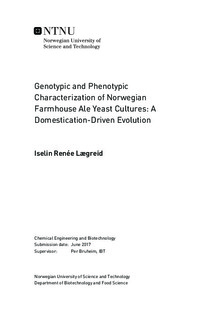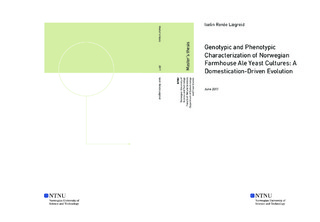| dc.description.abstract | There is an immense gap in our knowledge regarding biodiversity of yeasts and the available untapped yeasts that can be found in nature. Studying both domesticated and wild species is important as it can enable us to better understand the natural history, and potentially reveal how selective pressures have affected and shaped its evolution. The yeast Saccharomyces cerevisiae has been used for thousands of years by mankind to produce the most consumed fermented beverage in the world; beer. Recently, the domestication and divergence of S. cerevisiae beer yeasts has been thoroughly studied. However, very little is known about the evolution and phenotypic behaviour of the Norwegian farmhouse ale yeast (NFAY) cultures that were used in traditional home-brewed beer.
In this work, 14 different NFAY cultures with a total of 24 yeast isolates, were characterized and compared with S. cerevisiae laboratory strains and commercially available beer yeasts. The yeasts were taxonomically classified at genus and species levels by sequencing of rRNA gene regions; internal transcribed spacer (ITS) region and partially sequencing of the large subunit (LSU), referred to as LSU1 and LSU2. Since incomplete fermentation of maltotriose is a common problem in the brewing industry and maltotriose utilization is highly associated with domestication, the presence and distribution of a gene encoding an α-glucoside transporter, AGT1, was investigated. This transporter has a wide substrate specificity for common sugars in the wort, including maltotriose. Moreover, the ploidy was investigated with flow cytometry, and a small-scale fermentation of the samples was carried out at 22 °C and 35 °C. The fermentation performance, as well as its flavor and aroma profile, was determined with chromatography and mass spectrometry instrumentation (headspace GC-MS, HPLC and LC-MS).
The species differentiation based on the ITS and LSU regions suggested that the NFAY cultures consist of at least three different species; Saccharomyces cerevisiae, Saccharomyces bayanus and the less familiar non-Saccharomyces yeast Meyerozyma caribbica. The Saccharomyces species seems to be closely related, as it was generally observed low DNA sequence divergence among them. The AGT1 allele was present in all Saccharomyces species except two of the the laboratory strains. It was discovered that a particular AGT1 gene mutation producing a premature stop codon may not be limited to lager strains, as presumed before. Interestingly, the NFAY samples carried a variant of the AGT1 gene that is more similar to the domesticated ones rather than wild S. cerevisiae variants. This raises the suspicion of them originating from domesticated ancestors. Phenotypic variants among the NFAY samples were also observed, and were different from the performance of commercial yeasts. This diversity is believed to have emerged from the farmhouse brewing traditions, through high fermentation temperatures, unique storage techniques and repitching. However, the phenotypic traits were not conserved within the three species, nor did they carry geographical structure. This can indicate that the phenotypic characteristics are mainly strain dependent. This, together with high maltotriose utilization, low sequence divergence and wide geographical dispersal, further supports the theory of a domestication-driven evolution in the NFAY cultures. | |

